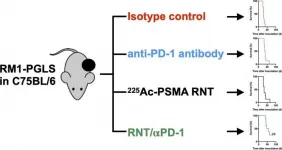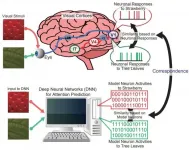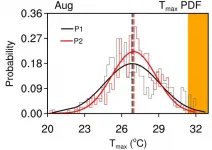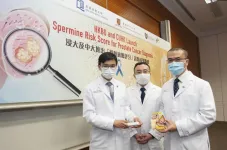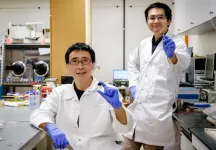(Press-News.org) Scientists at HSE University have learned that disagreeing with the opinion of other people leaves a 'trace' in brain activity, which allows the brain to later adjust its opinion in favour of the majority-held point of view. The article was published in Scientific Reports.
We often change our beliefs under the influence of others. This social behavior is called conformity and explains varios components of our behaviour, from voting at elections to fashion trends among teenagers.
Brain research has recently well informed about short-term effects of social influence on decision making. If our choice coincides with the point of view of the people who are important to us, this decision is reinforced in the brain's "pleasure" centres involved in the larger dopaminergic system responsible for learning, motor activity and many other functions. Conversely, in instances of disagreement with others, the brain signals that a 'mistake' has been made and triggers conformity.
However, there is little study of how social influence affects brain activity once some time has passed after we have formed an opinion and learned of the opinion held by others. HSE neuroscientists decided to study whether the opinion of others causes long-term changes in brain activity. The scientists used magnetoencephalography (MEG), a unique method that allows you to see in detail activity of the human brain during information processing, and it has a temporal resolution higher than that of traditional fMRI.
At the beginning of the experiment, 20 female participants rated the degree to which they trusted strangers whose faces were depicted in a series of photographs. They then were informed about the collective opinion of a large group of peers on whether to trust these strangers. Sometimes the opinion of the group contradicted the opinion of the participants, and sometimes it coincided with it. After half an hour, the subjects were asked to reassess their trust to the same strangers.
The study showed that the participants changed their opinion about a stranger under the influence of their peers in about half of the cases. In addition, changes occurred in their brain activity: scientists discovered 'traces' of past disagreements with peers. When the subjects again saw the face of a stranger, after a split second, their brain signaled that last time their personal opinion did not coincide with the assessment given by their peers. Most likely, the fixation of this signal allows the brain to predict possible conflicts in the future arising from disagreements in order to avoid them, and this probably occurs subconsciously.
It is interesting that an area such as the superior parietal cortex, an area of the brain responsible for retrieving memories, is involved in coding the signal of past disagreements with the group. It is likely that the faces of strangers, about whom the brain encountered a difference of opinion, are remembered better than others.
Thus, the opinions of others not only influence our behavior, but also cause long-term changes in the way our brains work. Apparently, the brain not only quickly adjusts to the opinions of others, but also begins to perceive information through the eyes of the majority in order to avoid social conflicts in the future.
'Our study shows the dramatic influence of others's opinion on how we perceive information,' says HSE University Professor Vasily Klucharev, one of the authors of the study. 'We live in social groups and automatically adjust our opinions to that of the majority, and the opinion of our peers can change the way our brain processes information for a relatively long time.'
'It was very interesting to use modern methods of neuro-mapping and to see traces of past conflicts with the opinion of the group in the brain's activity,' adds Aleksei Gorin, a PhD student at HSE University. 'The brain absorbs the opinion of others like a sponge and adjusts its functions to the opinion of its social group.'
INFORMATION:
Once the paper is published, it will be available to view online at http://www.nature.com/articles/s41598-021-82670-x. EMBARGOED until 8 February 2021, 05:00 US Eastern time / 10:00 London time (GMT).
Reston, VA--A combination of radionuclide therapy and immunotherapy has proven successful in slowing the progression of prostate cancer and increasing survival time, according to new research published in the February issue of The Journal of Nuclear Medicine. The results of the murine study indicate that radionuclide therapy promotes prostate cancer immunogenicity, provoking a cellular response that makes the tumors more receptive to immunotherapy.
"Prostate cancer is generally viewed as an immunological cold cancer in which immunotherapies only have moderate success," said Katharina Lückerath, PhD, assistant professor of preclinical ...
Geoscientists have released a video that for the first time shows the uninterrupted movement of the Earth's tectonic plates over the past billion years.
The international effort provides a scientific framework for understanding planetary habitability and for finding critical metal resources needed for a low-carbon future.
It reveals a planet in constant movement as land masses move around the Earth's surface, for instance showing that Antarctica was once at the equator.
The video is based on new research published in the March 2021 edition of ...
This discovery was made possible by applying the research method for the comparison of the brain activity between monkeys and humans to artificial neural networks. This finding might be helpful not only to understand the cortical mechanism of attentional selection but also to develop artificial intelligence.
Deep neural networks (DNNs), which are used in the development of artificial intelligence, are mathematical models for obtaining appropriate mechanisms to solve specific problems from the training with a large-scale dataset. However, the detailed mechanisms underlying DNNs through ...
On Feb 5th, Seoul National University, College of Engineering (Dean Kookheon Char) announced that Professor Sang Woo Seo's research team (Dr. Jina Yang and Mr. Yong Hee Han (graduate student)) at School of Chemical and Biological Engineering has developed a synthetic protein quality control system to enhance full-length translation in bacteria. This technology is expected to increase the efficiency of the production of biopharmaceuticals, industrial enzymes, and bio-based chemicals.
Recombinant proteins are used in various industrial fields from protein drugs such as insulin to industrial proteins such as laundry detergents. Since proteins can perform their functions only with full-length and proper 3D structure, recombinant protein production ...
Against the background of global warming, extreme heat days (EHDs) occur frequently and greatly threaten human health and societal development. Therefore, it is of great importance to understand the variation of EHDs.
Previous studies have indicated that the frequency of EHDs is mainly modulated by the mean state of temperature, and thus the frequency of EHDs mostly presents an increasing trend.
"However, the variability of the daily maximum temperature also plays an important role in the interdecadal change of extreme heat days over Northeast China," says Ms. Liu Wenjun, a Master's student from the group of Dr. Ruidan Chen in the School of Atmospheric Sciences ...
Researchers from Hong Kong Baptist University (HKBU) and the Faculty of Medicine at The Chinese University of Hong Kong (CU Medicine) have jointly developed the Spermine Risk Score which, coupled with the use of a urine test, provides a non-invasive and more reliable method for the diagnosis of prostate cancer. In a study conducted by the researchers, about 37% of the patients, who were ultimately found to have no prostate cancer, can avoid undergoing a prostate biopsy procedure. The findings have just been published in the scientific journal Prostate Cancer and Prostatic Diseases.
Demand for more reliable and non-invasive diagnosis
Prostate cancer is the third most common and the fourth most fatal cancer for the male ...
Which bananas end up in your shopping basket-- the uniformly yellow ones or those with brown spots?
If you are like most people, you skip the spotted ones and select those that are perfectly yellow. This is because emotions play an an oversized role in our shopping decisions, according to a new study by Danish and Swedish researchers.
"We choose food based upon an expectation of what it will taste like that is bound to our feelings. So, if we expect a brown banana to not match the taste of a yellow one, we opt for the latter," explains Karin Wendin, an associate professor at University of Copenhagen's Department of Food Science, and one of the researchers behind the study.
Approximately 716,000 tonnes ...
A team of researchers led by Nanyang Technological University, Singapore (NTU Singapore) has developed a new material, that when electricity is applied to it, can flex and bend forty times more than its competitors, opening the way to better micro machines.
Conversely, when it is bent, it generates electricity very effectively and could be used for better "energy harvesting" - potentially recharging batteries in gadgets just from everyday movements.
The novel material is both electrostrictive and piezoelectric. Its electrostrictive properties means it can change shape when an electric current is applied, while piezoelectric means the material can convert pressure into electric charges.
When an electric field is applied, the atoms that make up electrostrictive ...
Although SGLT-2 inhibitors are central to the treatment of diabetes, their exact mode of action was hitherto unknown. In a study conducted by a research group led by Peter Wolf, Martin Krssak and Michael Krebs from MedUni Vienna's Department of Medicine III, magnetic resonance spectroscopy (MRS) was used to show that there is a direct correlation between the elimination of glucose via the kidneys and new glucose production in the liver. A single dose of the SGLT-2 inhibitor dapagliflozin gives rise to a beneficial regulation mechanism, in which glucose loss due to drug-induced SGLT-2 inhibition is exactly balanced out by an equal increase in new glucose production in the liver. The study has been published in the leading journal Diabetes Care.
Dapagliflozin is a drug from the group ...
Researchers at the Kobe University Graduate School of Science have revealed that when captive-bred juvenile red-spotted masu salmon are released into natural streams, very few individuals become migrants.
Red-spotted masu salmon was an important fish species for the fishing industry in the rivers of west Japan, however in recent years their numbers are declining rapidly. The results of this research offer important suggestions for stocking practices and the management of river environments.
The research group consisted of graduate school students TANAKA Tatsuya and UEDA Rui and Associate Professor SATO Takuya. The results were published in Biology Letters ...

